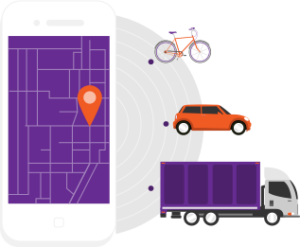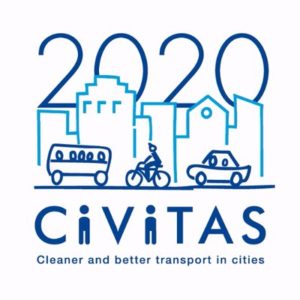Crowdsourcing concept
Intelligent Transportation platforms and their applications are attracting notable attention in the supply chain. By means of sensing and communication technologies, the smart transport systems assist transportation authorities and vehicles drivers in making informative decisions. Data collection and more importantly the use of the collected data analysis are crucial elements in the intelligent transportation. In these platforms, the vehicles and cars are equipped with proper sensing and communication capabilities such as drivers’ mobile phones.
The term, ‘crowdsourcing’ is somehow a new approach, but the basic idea of crowdsourcing has been already used in other dimensions of society, as social, political, technological aspects have grown increasingly in an integrated and connected way. Crowdsourcing involves leveraging the collective knowledge, or experience of a number of people to manage a process. Leveraging a network of connected devices for transportation system management in an intelligent way is an important opportunity. The basic idea behind the Crowdsourcing concept is to use the smart mobile phones to enable transport-logistics applications without the need for any specific sensors or communication devices, both in-vehicle, and cars.

Crowdsourced Transportation Platforms
Among different Intelligent Transport platforms, Crowdsourced Transportation Platforms (Road) getting more growing significantly. Within the supply chain scope, a growing number of Uber-like platforms for commercial transportation are entering the market in the U.S. as well as in Europe. Last-mile logistics represents a good near-term opportunity for crowdsourcing transportation. Crowdsourcing is a solution to the multi-dimensional problems in the management of complex systems.
The range of problems that can be addressed through crowdsourcing has greatly increased in recent years with the broad adoption of internet-connected devices, especially smartphones. Crowdsource delivery platforms making inroads into the commercial transportation sector with the goal to match over-the-road (OTR) carriers’ capacity with shippers’ demand. These solutions allow shippers to instantly book the loads they want to haul. This kind of on-demand offering, which sources transportation needs to abroad, the online community of shippers and carriers through the use of Uber-like social collaboration techniques, is seen increasingly in the transportation market with strong backing from the private equity community.
 There are some ongoing projects and studies for establishing Crowdsourced Transportation platforms around the world. An example is BUSUP Project: Multi-platform On-demand Crowdsourced Bus Transportation for Smart City Mobility. It allows travelers to book-on-demand crowd-sourced buses for leisure and commuting. Users are able to set up their own routes in the web- platform and app. The Crowdsourcing Europe’s transport system of the future(CIVITAS) is also another intelligent platform for crowdsourcing. The CIVITAS is a network of cities for cities dedicated to a cleaner, better transport in Europe and beyond. Since it was launched by the European Commission in 2002, the CIVITAS Initiative has tested and implemented over 800 measures and urban transport solutions as part of demonstration projects in more than 80 Living Lab cities Europe- wide.
There are some ongoing projects and studies for establishing Crowdsourced Transportation platforms around the world. An example is BUSUP Project: Multi-platform On-demand Crowdsourced Bus Transportation for Smart City Mobility. It allows travelers to book-on-demand crowd-sourced buses for leisure and commuting. Users are able to set up their own routes in the web- platform and app. The Crowdsourcing Europe’s transport system of the future(CIVITAS) is also another intelligent platform for crowdsourcing. The CIVITAS is a network of cities for cities dedicated to a cleaner, better transport in Europe and beyond. Since it was launched by the European Commission in 2002, the CIVITAS Initiative has tested and implemented over 800 measures and urban transport solutions as part of demonstration projects in more than 80 Living Lab cities Europe- wide.
Benefits and challenges:
Many claims that the Benefits of the intelligent crowdsource systems overweight its relevant problems. The traditional asset-heavy approach to last-mile delivery is expensive and inflexible. It will be higher in cost as retailers look to gain a competitive advantage by offering next-day and same-day delivery options. Certain product types that have the same-day delivery expectation from consumers (e.g. Restaurant, flowers, grocery) have been pioneers of this kind of delivery method and prove that this model has valid applications. Therefore, this kind of data-sharing will result in improved customer experience. Private enterprises and even the local authorities can use the captured data to design and plan the future services for customers and citizens in an efficient way. It helps meet the challenges such as street parking availability, highway and street traffic conditions to give the accurate estimation of goods delivery with a reduced time and cost. For public it has the positive side effect of reduced traffic and air pollutions with the related externality costs. Integration of the data-sources with private-ridesharing and parking-apps will empower optimization in multi-modal transport systems and also meet the new customer preferences.
Another benefit of these approaches could be the systematic use of information and data analysis from users for the purpose of transportation planning and/or for optimizing the customer service. Comprehensive and real-time data sharing, allows these platforms to overtake the inefficient and traditional methods of transportation. With access to data collection and proper analysis, the best solution in last mile transport of goods could be offered for the end users. Crowdsourcing also provides an ideal platform for engaging small and medium enterprises with limited financial capacities to overcome the monopoly of the last-mile transport companies.
However, there are still challenges related to these types of platforms that to be addressed. For example: does the crowdsourcing systems will be able to partly replace the traditional trucking transportation needs? Regarding the majority of cargoes and goods are for heavy freight and under a contract with a commercial transportation carrier over longer distances. Another barrier could be the synchronizing the multiple modes and also necessary exception handling for service issues such as equipment breakdowns. A high portion of the shipments is high-value and time-sensitive, which doesn’t fit the crowdsourcing model.
Future Perspective
Although last-mile logistics represents a good opportunity for crowdsourcing transportation, it is still early to say if the crowdsourcing format can work for traditional trucking transportation needs. Shippers that mostly used contracted carriers for their long-haul transportation will find less value in these platforms. While the crowdsourcing model might be interesting, the large carriers are already dominant in the market and shaped the market in favor of operation for a long-haul truck. However, crowd-sourcing has been attracting increasing attention and is re-mapping the transport grid. Traditional methods of communicating with end- users in the supply chain, such as paperwork, are rapidly being replaced by ‘crowdsourced’ applications that alerts to a user’s location, route, and transportation preferences. Crowd-sourced apps on smart mobiles act as a two-way street for transportation agencies and customers. The data from transit apps are helping make smarter infrastructure decisions and improve customer services
Crowdsourcing issues are mostly concentrated around problems with the quality, accuracy, and aggregation of data. However, these issues could be solved via appropriate planning and with a complete understanding of the final goal of the crowdsourcing platform. The growth of new initiatives and modern technologies allows the crowdsourcing systems to be smart and also create a nascent, three-party relationship between application developer, end-user/customers, and public transport authorities such as municipalities. In the mid of complicated logistics problems, crowd-sourced data promises an opportunity to improve the last-mile delivery solutions with maximized, but sustainable asset utilization.
Author: R.Karimpour

